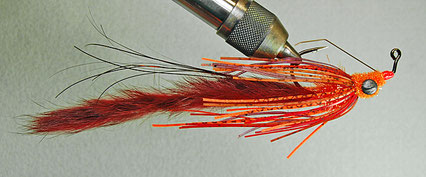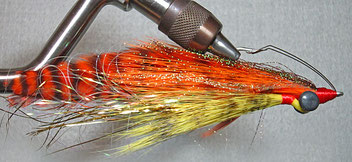Text and images by Craig Smith

The kelp bass, commonly called the “Calico” bass have been a popular game fish in Southern California for decades with conventional anglers. A long time staple of the local half and three-quarter day sport fishing party boats, they have become more popular with fly anglers over the last twenty years. The calico bass fishing around the kelp beds off of Pt. Loma and La Jolla has been excellent all summer and continues to be good. These powerful predators readily take the fly when on the feed and can put up a very intense battle as they try to lunge for the safety of kelp or rocks. As hinted at by their name, kelp (calico) bass are found, as you would expect, around kelp. They are also found around rocky structure including man made rip rap and jetties. Calico bass average about two pounds but double digit fish are occasionally taken by conventional gear anglers using lead head jigs. The largest documented fly caught calico is a 9.4 lb lunker taken in 2016 by Southern California angler Al Quattrocchi on 12 lb. tippet that is an IGFA record. Four to five pound fish are fairly common. Most larger fish are taken during periods of low light.

Fly anglers pursue calico bass with 8 to 10 weight fly rods. Due to the fact that most fish are taken in proximity to cover and structure, rarely is a calico bass fought on the reel. However other species such as yellowtail, bonito, barracuda, and white sea bass may be encountered in the same areas so we recommended employing a reel with a good drag and at least 150 yards of backing.

Calico bass may be taken with fly tackle from near the surface, to depths of about 30 feet so fast sinking lines are usually used. Some of the most popular lines include integrated shooting taper lines such as the Rio Outbound Short S6, Rio Striper, and Rio Outbound Custom T-11 and T-14 lines. Scientific Anglers, Cortland, Airflo and other companies make similar lines. The fastest sinking rig easily handled by most anglers consists of a 30 foot Rio Intouch T-11 or T-14 shooting head looped to a thin shooting line. The dense shooting head mated with a thin shooting line will sink a bit faster than a full length flyline. Leaders can be as simple as 6 to 8 feet of 12 to 20 pound nylon or fluorocarbon monofilament looped to the fly line. Calico bass can also be taken on topwater patterns with a floating line when they push bait to the surface. The crash of a calico bass taking a popper, crease fly, or gurgler pattern is a sight to behold.

Calico bass have large mouths and can ingest large meals. They will feed on anchovies, sardines, small mackerel, smelt, squid, crabs, and just about anything else they can get in their mouths. The Clouser Deep Minnow in sizes 2/0 and larger is one of the most popular commercially available patterns for calico bass. A Clouser Half and Half (Clouser minnow with a Lefty’s Deceiver tail) combines attributes of two great fly patterns to create a larger fly with bulk and length. Most calico bass anglers tie their own patterns that will sink fast yet offer some bulk to look like a sizable meal. Many incorporate rubber legs or skirts to add some lifelike motion. Installation of a weed or snag guard will help keep flies from getting stuck in kelp or in rocks.

Though calico bass can be targeted year round, the peak months off of San Diego are June through August with good fishing available into early October many years. Exotic gear is not required to target calicos, in fact if you have a setup for largemouth bass you probably have what you need with the addition of a sinking line if you do not already have one. If you are looking some exciting Southern California inshore saltwater fly fishing get out and after some calico bass.
